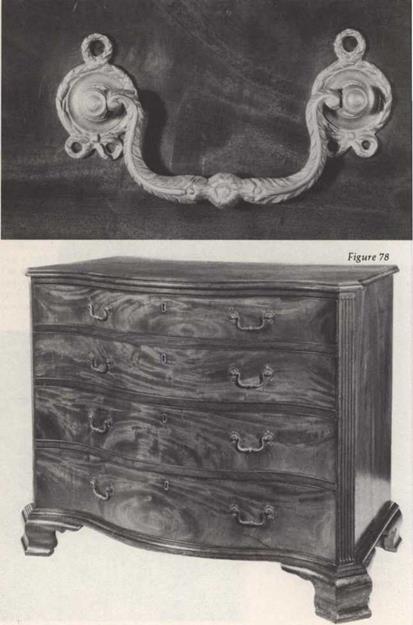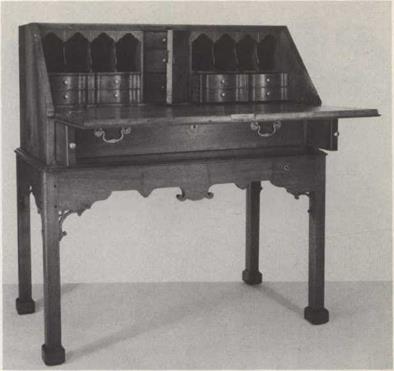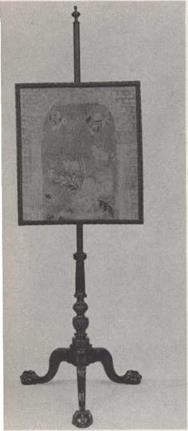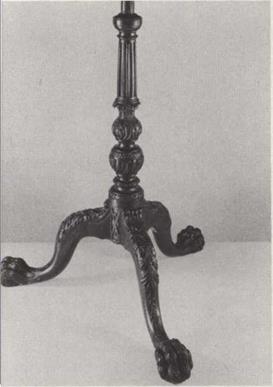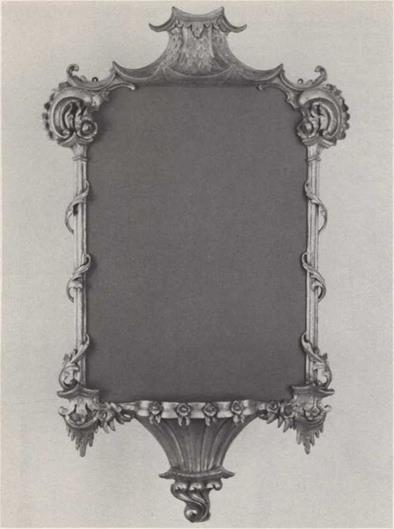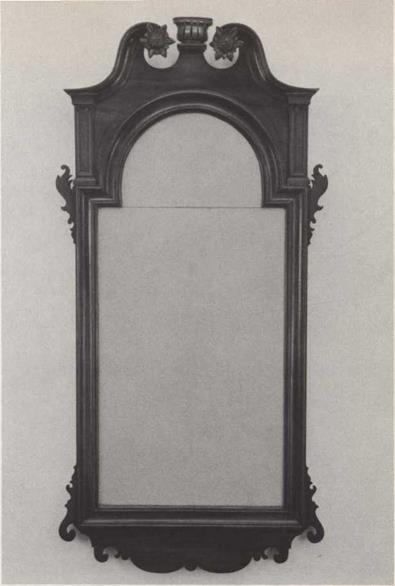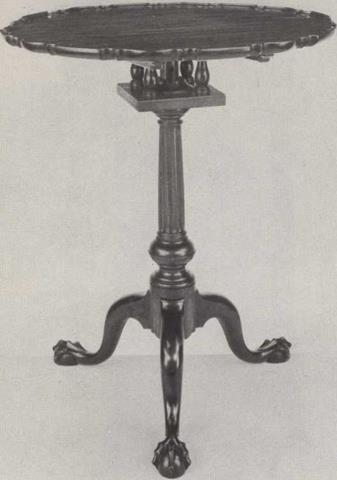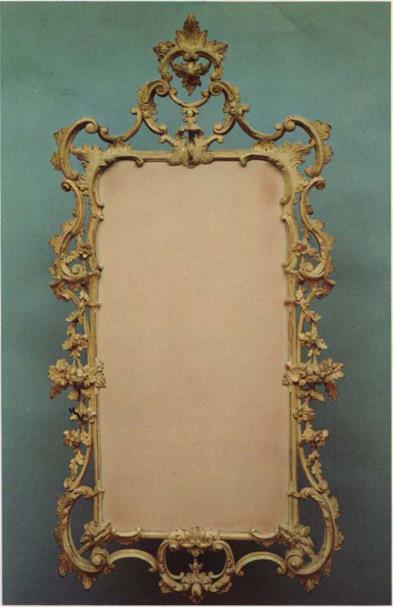|
Figure 73. Settee. This settee’s claw-and-ball feet relate to other Philadelphia seating furniture. Carved shells in high relief on a shaped skirt are also familiar. Carving on the front rail at the juncture of legs and seat was shown on a side chair (Fig. 62). Settees were not a common form of seating furniture in any of the colonies, perhaps because a full-length walnut sofa frame with cabriole legs and carved knees was only slightly more expensive than a settee. Fig. 73: mahogany, white oak, yellow pine; -~i76S’-80; L (seat rail) 66lA" (168.2 cm); acc. no. C60.1057. |
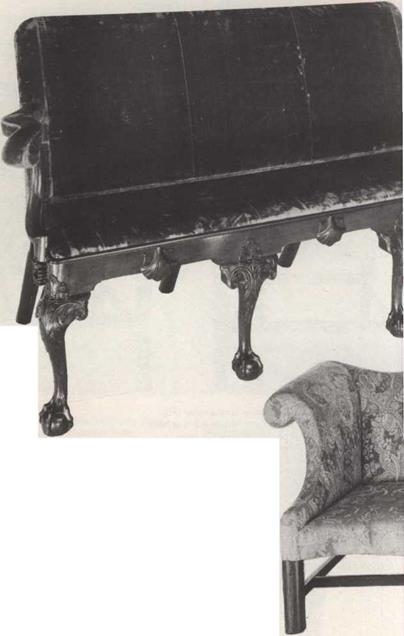
 Figure 74. Sofa. Sofa prices are quoted in 1772 and 1786 Philadelphia price lists, but few advertisements for sofas appear in newspapers of the period, fewer are listed in inventories, and even fewer survive. John Cadwalader purchased 3 “Mahogany Commode Sophas for the Recesses" from Thomas Affleck in 1770 at a cost of 26 pounds.
Figure 74. Sofa. Sofa prices are quoted in 1772 and 1786 Philadelphia price lists, but few advertisements for sofas appear in newspapers of the period, fewer are listed in inventories, and even fewer survive. John Cadwalader purchased 3 “Mahogany Commode Sophas for the Recesses" from Thomas Affleck in 1770 at a cost of 26 pounds.
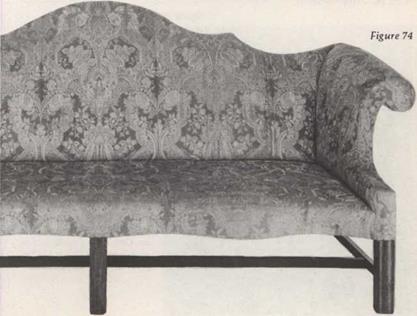
The upholsterer, John Webster, covered them in silk damask, lined and fringed, after Plunket Fleeson, also an upholsterer, had stuffed them with hair, covered them with canvas, and made cases. Complete, the 3 sofas cost 42 pounds, 7 shillings, and 10 pence.29 "Commode" referred to a swelled, or serpentine, front. Fig. 74: mahogany: 1770-80; iV 98V. t" (249.4 cm); асе. no. C51.7.
Figures 75 and 76. Back – and Foot Stools. In discussing a New York example (Fig. 13) it was stated that upholstered side chairs were known in the Chippendale period as back stools. Charles Allen, a Philadelphia upholsterer, advertised in 1774 that he made “back – stool chairs. "30 This form is probably what is referred to in a Philadelphia price list of 1772, as simply “Chair Frame for Stuffing over back and Seat with Marlborough feet." The serpentine front rail and cyma-curved stiles of the back frame undoubtedly were an “extra." A set of
 back stools at Cliveden, Germantown, Penn., have similar backs.31 Footstools were rarely made and few have survived. On Figure 76, balanced carving in the "modern taste" on its knees and brackets combine with its oval shape as a reflection of the classical taste that was such a strong influence on English and American furniture decoration in the Chippendale period.
back stools at Cliveden, Germantown, Penn., have similar backs.31 Footstools were rarely made and few have survived. On Figure 76, balanced carving in the "modern taste" on its knees and brackets combine with its oval shape as a reflection of the classical taste that was such a strong influence on English and American furniture decoration in the Chippendale period.
Fig. 75: mahogahy, red gum, red and white oak; 1765-80; H 38%" (98.1 cm); acc. no. G61.1199. Fig. 76: mahogany; 1755-75; H 17V. i" (44.5 cm); acc. no. G56.579.
![]()
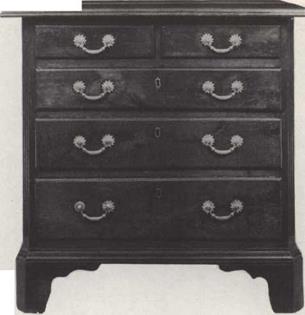 Figure 77
Figure 77
Figure 77. Chest of Drawers. Without William Savery’s label (Fig. 77a), this chest of drawers might have been considered an example of rural cabinetwork. City craftsmen served clients living outside Philadelphia, but there was also a strong demand for plain furniture within the city (Figs. 43,

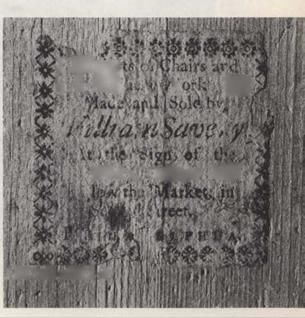 44). Fluted, chamfered corners, cyma-curve shaped bracket feet, ogee molding on the edges of its top, and quarter-round molding on the drawers are its only decoration. Fig. 77: walnut, white cedar; 1755-65; H 32Ve" (83.5 cm); acc. no. G59.632.
44). Fluted, chamfered corners, cyma-curve shaped bracket feet, ogee molding on the edges of its top, and quarter-round molding on the drawers are its only decoration. Fig. 77: walnut, white cedar; 1755-65; H 32Ve" (83.5 cm); acc. no. G59.632.
|
|
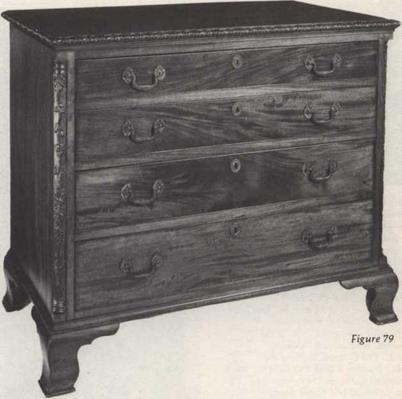
Figure 78. Chest of Drawers. A similar chest of drawers at Cliveden, Germantown, Penn., bears the label of Jonathan Gostelowe (1744-95).32 Unmarked examples of the same form—fluted, chamfered corners on the case; canted corner top and front feet to match; ogee bracket feet; and serpentine front and top—are usually attributed to him. This example was probably made after 1783 because its original Adam-style drawer pulls and backplates (Fig. 78a) appear in a catalog of English hardware dating between 1783 and 1789. Fig. 78; mahogany, yellow pine, tulip; 1780-90;
H 36V (91.7cm); acc. no. G59.631. Figure 79. Chest of Drawers. This is the usual form of Philadelphia chests of drawers. A case of four long drawers is supported by swell’d (ogee) bracket feet. Indented quarter columns, usually fluted, are almost invariably at the front corners. These bear exceptional relief carving of a floral and leaf vine. Top edges are usually plain, but these are treated in a very architectural manner with leaf-and-dart carving. Fig. 79; mahogany, white cedar, yellow pine, tulip; 1760-80; H 35’A" (89.5 cm); acc. no. G59.1474.
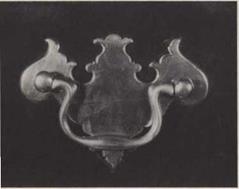
Figure 80. Chest-on-Chest. The top section of a high chest placed on a chest of drawers was known as a chest- on-chest. They were made in all the colonies during the Chippendale period. Charlestonians and New Yorkers preferred theirs with flat tops instead of the broken-arched, scrolled pediments popular elsewhere. Philadelphia examples have 10 to 12 drawers, and price lists indicate that the base charge for this form in mahogany with "scroll pediment, head carved," was 21 pounds. The C-scroll, leaf and tree carving framing a lamb and ewe (Fig. 80a) is balanced but rococo in content and spirit. Indented and fluted quarter columns usually decorate the corners of Philadelphia case pieces. The brasses (Fig. 80b) were still offered in English metal trade catalogs of the late 18th century. The finials and cartouche are replacements made by the late Jesse W.
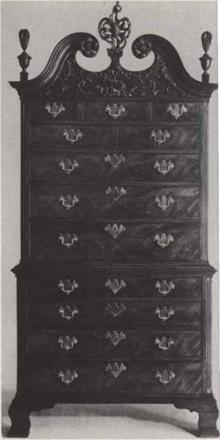
![]()
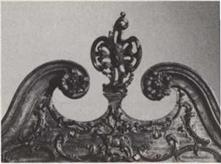 Bair of Hanover, Penn. Fig. 80: mahogany, mahogany veneer, white cedar, white oak;
Bair of Hanover, Penn. Fig. 80: mahogany, mahogany veneer, white cedar, white oak;
1760-75; H 86" (218.4 cm); acc. no. C60.1056.
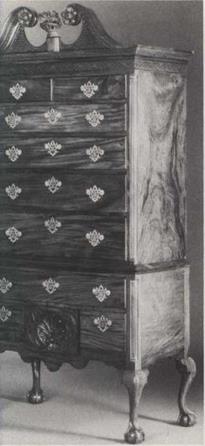

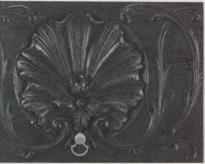
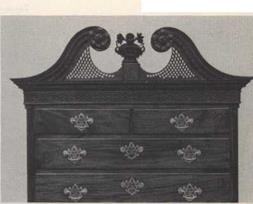 |
Figure 81. High Chest of Drawers. High chests of drawers were the second most popular type of case furniture made in Philadelphia. Priced 6 pounds less than a chest-on-chest, patrons obtained almost as many drawers, relief from the feeling of weightiness, and the popular cabriole legs and claw-and-ball feet. A carved Chinese and Gothic blind fret decorates the frieze, and large pierced frets tie scrolled arches to a pedestal block at the center of the pediment (Fig. 81a). Handsome relief carving of a large shell, rosette, and ribboned leaves decorates the center drawer of the base section (Fig. 81b). This carving is related in quality and design to that of the famous Van Pelt high chest (Fig. 83). The Delaware River helped to distribute the products of Philadelphia cabinetmakers, as evidenced by the fact that Figure 81 was originally owned by Joseph Shipley of Wilmington, Del. Fig. 81: mahogany, tulip; 1760-75; H 9W (232.4 cm); cartouche old but replaced; anonymous donor; acc. no. G69.204.
Figure 82. High Chest of Drawers. VJas this high chest made early in the Chippendale period, and therefore in Philadelphia, or late in this style period, and therefore in Maryland? Its plain quality does not necessarily make it rural, for much plain furniture was made in Philadelphia. Its wood is walnut, a wood consistently used for Philadelphia furniture during this period. Significantly, a mahogany dressing table of very similar design and decoration was exhibited at The Baltimore Museum of Art in 1968. Evidence for a Maryland origin included ".its broad, fluted chamfer and the leaf carving on the knees of the cabriole legs,"33 These are features exhibited by Figure 82, but Philadelphia and New York case furniture often has fluted, chamfered corners. In the absence of fully documented examples, the distinction may never be known. Cerrard Hopkins, a cabinet – and chairmaker from Philadelphia, had a shop on Gay Street, Baltimore, where in 1767 he advertised "Chests of Drawers of various sorts.
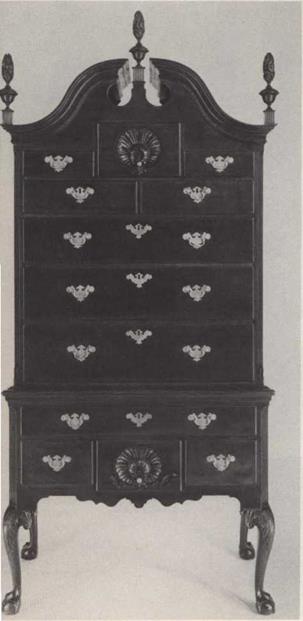 Fig. 82: walnut, white cedar, tulip; 1755-75; H 96V” (244.4 cm); acc. no. G59.1862.
Fig. 82: walnut, white cedar, tulip; 1755-75; H 96V” (244.4 cm); acc. no. G59.1862.
Figure 83. High Chest of Drawers.
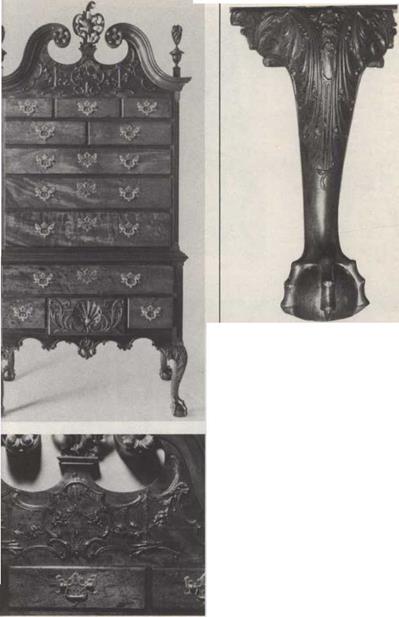 Figure 83 and Plate XI are examples of the finest Philadelphia furniture.
Figure 83 and Plate XI are examples of the finest Philadelphia furniture.
Added to the basic high-chest form are applied high-relief carving of C-scrolls, rocks, Gothic columns, dripping vegetation, and floral vines (Fig. 83a). Carved leaf ribbons flank a handsome shell and rosette on the center drawer of the lower section (cf. Fig. 81b). On the lower edge of the skirt is a pierced pendant flanked by C-scrolb and leaves. Flowers, husks, and leaves ornament the deeply carved knees of its front legs (Fig. 83b). The typical Philadelphia claw-and-ball foot is evident. Fig. 83: mahogany, white cedar, white oak, yellow pine, tulip; 1765-80; H 90’k" (229.2 cm); cartouche replaced by Jesse W. Bair, Hanover, Penn.; originally owned by John or William Turner and subsequently by the Van Pelt family; acc. no.
G58.592.
Figure 84. Desk-on-Frame. Indented, fluted quarter columns, and claw-and-ball feet are the latest exterior features of this desk-on-frame. Used since the late 17th century, only a few were made by the introduction of Chippendale style. The 1772 and 1786 Philadelphia price lists for cabinetwork do not record the form. A serpentine shape, popular in the Chippendale period, was used fora double bank of drawers in the interior of the desk section (Fig. 84a). Fig.
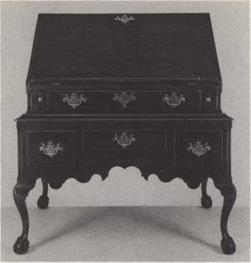
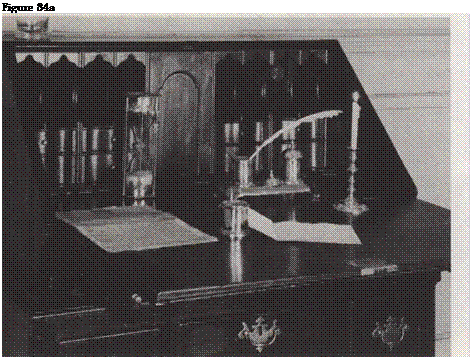 84: walnut, chestnut, tulip; 1755-65; H 42" (106.7 cm); acc. no. C58.2263.
84: walnut, chestnut, tulip; 1755-65; H 42" (106.7 cm); acc. no. C58.2263.

![]()
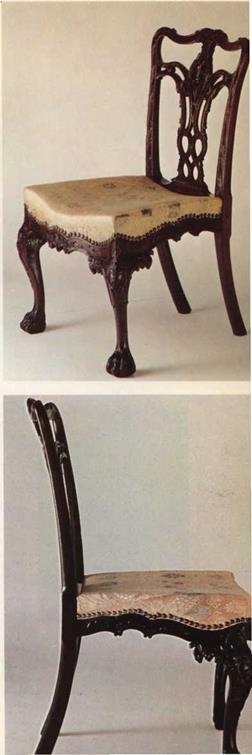 Plate IX. Side Chair. This side chair represents the best type of Philadelphia chairmaking that has survived. Described for many years as a so-called sample chair, it has been attributed to the Philadelphia cabinetmaker Benjamin Randolph because of its descent in the family of that craftsman’s second wife. Until 1974, when 5 side chairs, identical or nearly so, were sold at Sotheby Parke-Bernet, this chair was thought to be unique. Not a sample chair, it could have been made by a number of excellent Philadelphia cabinetmakers and carvers. Its secondary woods; stump rear legs; side rails tenoned through the rear stiles; characteristic curved side profile of its back (PI. IXa); high-relief carving of cabochon, leaves, husks (PI. IXb); and hairy paw feet mark its origin as Philadelphia. Its saddleshaped seat is unusual, but this guidebook illustrates other Philadelphia chairs with partially upholstered seat rails (Figs. 53, 58; PI. VII). Although its carved front seat rail is similar to the front of a card table made for John Cadwalader, a chair of this type appears in a portrait of Lambert Cadwalader painted by Charles Willson Peale.35 PI. IX: mahogany, arborvitae, white cedar; 1760-75; H 36Vh" (93.6 cm); no. II of a set; upholstered in French silk lampas, (ca. 1735); acc. no. G58.2290.
Plate IX. Side Chair. This side chair represents the best type of Philadelphia chairmaking that has survived. Described for many years as a so-called sample chair, it has been attributed to the Philadelphia cabinetmaker Benjamin Randolph because of its descent in the family of that craftsman’s second wife. Until 1974, when 5 side chairs, identical or nearly so, were sold at Sotheby Parke-Bernet, this chair was thought to be unique. Not a sample chair, it could have been made by a number of excellent Philadelphia cabinetmakers and carvers. Its secondary woods; stump rear legs; side rails tenoned through the rear stiles; characteristic curved side profile of its back (PI. IXa); high-relief carving of cabochon, leaves, husks (PI. IXb); and hairy paw feet mark its origin as Philadelphia. Its saddleshaped seat is unusual, but this guidebook illustrates other Philadelphia chairs with partially upholstered seat rails (Figs. 53, 58; PI. VII). Although its carved front seat rail is similar to the front of a card table made for John Cadwalader, a chair of this type appears in a portrait of Lambert Cadwalader painted by Charles Willson Peale.35 PI. IX: mahogany, arborvitae, white cedar; 1760-75; H 36Vh" (93.6 cm); no. II of a set; upholstered in French silk lampas, (ca. 1735); acc. no. G58.2290.
|
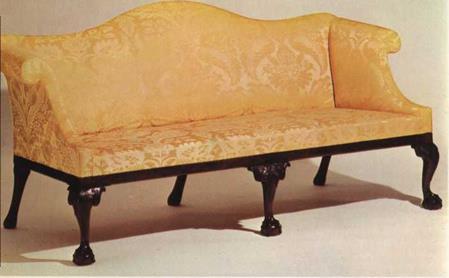
 Plate X. Sofa. As on Philadelphia chairs, a few of the sofas made there have partially upholstered front rails. Hornor shows a similar sofa, with identical leg carving (PI. Xa) and partially upholstered seat rail, made in 1783 for George Logan of Stenton by Thomas Tufft(w. 1772-88). George Washington had a similar sofa in his Philadelphia presidential home.™ The name of John Linton (an upholsterer who settled in Philadelphia about 1780) is signed in chalk on the top rail of one of this pair. John Dickinson, “Penman of the American Revolution," was the original owner of these. He lived in Philadelphia untilil794, then moved to Wilmington, Del. The sofas are upholstered in Italian silk damask (ca. 1725). PI. X: mahogany, white oak, yellow pine; 1775-90; W 79V (202.6 cm); one of a pair; acc. no. G58.593.
Plate X. Sofa. As on Philadelphia chairs, a few of the sofas made there have partially upholstered front rails. Hornor shows a similar sofa, with identical leg carving (PI. Xa) and partially upholstered seat rail, made in 1783 for George Logan of Stenton by Thomas Tufft(w. 1772-88). George Washington had a similar sofa in his Philadelphia presidential home.™ The name of John Linton (an upholsterer who settled in Philadelphia about 1780) is signed in chalk on the top rail of one of this pair. John Dickinson, “Penman of the American Revolution," was the original owner of these. He lived in Philadelphia untilil794, then moved to Wilmington, Del. The sofas are upholstered in Italian silk damask (ca. 1725). PI. X: mahogany, white oak, yellow pine; 1775-90; W 79V (202.6 cm); one of a pair; acc. no. G58.593.
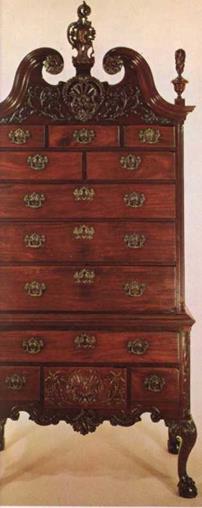 Plate XI. High Chest of Drawers. It is difficult to find carving in the "modern” taste more exuberant and better executed than that used on the high chest and matching dressing table made for Michael and Miriam Cratz in 1769 (Fig. 108, PI. XIa,). To provide additional variety, the indented quarter columns of its base section are carved but those of the upper section are fluted. Perhaps the largest Philadelphia peanut (cabochon) ever to be carved was placed in the cartouche. The latter appears to be completely asymmetrical in design, like the carved shell at the center of the skirt. The right portion of the cartouche is missing, however, and it was probably balanced by another C-scroll. Michael Cratz’s bride was a resident of Lancaster, Penn. It is possible that the abundance of carved decoration on this high chest is a reflection of a design with which she was familiar (cf. Fig. 87). The chinoiserie drawer pulls add another design element of this period to the form. PI. XI: mahogany, white cedar, tulip; H (cartouche tip) 102Уг" (260.2 cm); acc. no. C57.506.
Plate XI. High Chest of Drawers. It is difficult to find carving in the "modern” taste more exuberant and better executed than that used on the high chest and matching dressing table made for Michael and Miriam Cratz in 1769 (Fig. 108, PI. XIa,). To provide additional variety, the indented quarter columns of its base section are carved but those of the upper section are fluted. Perhaps the largest Philadelphia peanut (cabochon) ever to be carved was placed in the cartouche. The latter appears to be completely asymmetrical in design, like the carved shell at the center of the skirt. The right portion of the cartouche is missing, however, and it was probably balanced by another C-scroll. Michael Cratz’s bride was a resident of Lancaster, Penn. It is possible that the abundance of carved decoration on this high chest is a reflection of a design with which she was familiar (cf. Fig. 87). The chinoiserie drawer pulls add another design element of this period to the form. PI. XI: mahogany, white cedar, tulip; H (cartouche tip) 102Уг" (260.2 cm); acc. no. C57.506.
Plate XI
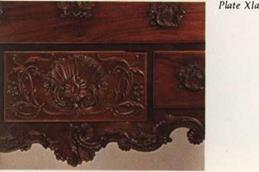
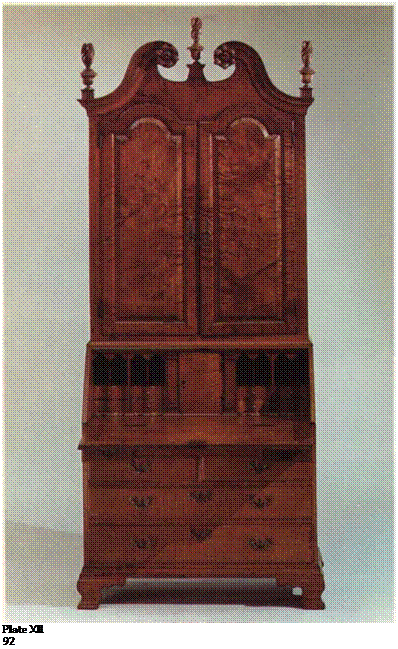
|
Figure 85 |
Plate XII. Desk and Bookcase. In the Middle Atlantic colonies, maple ranked fourth as a furniture wood.37 Peter Kalm noted that many trees had to be felled to obtain the desirable curled grain,38 Philadelphia chairmakers used maple for rush-bottomed chairs.39 Philadelphia features (Figs. 86-87) include broken arch scrolled pediment with carved rosettes, flame finials, and ogee-bracket feet. Two small drawers, instead of rectangular slides, support the fall-front lid. PI. XII: maple, white cedar, cherry, tulip;
1760-75; H 95" (241.2 cm); acc. no. 58.1450. Figure 85. Desk-on-Frame. Marlborough legs and feet; pierced C-scroll brackets between the front rail and legs; and a severe, shaped skirt give Figure 85 an Oriental flavor.
Eliminating drawers from the base section and using walnut instead of mahogany lowered its price. Another cost-cutting feature is the one long drawer simulating four small ones flanking the center door. Fig. 85: walnut, tulip; 1760-75; H 43W (110.8 cm); acc. no. G64.1064.
Figure 86. Desk and Bookcase. This desk and bookcase is a fine example of the understated elegance frequently presented by Philadelphia Chippendale – style furniture and is also a representative example of its form.
 Pediments are usually a broken-arch, swan-neck type with carved leaf volutes, as here, or rosettes. On Figure 86, the carved urn of leaves and flowers, carved drapery swag on its pedestal, and pierced fretwork of C-scrolled leaves were undoubtedly "extras."A dentilled cornice is not unusual, and a carved blind fret is often seen on the friezes of Philaldelphia desks and bookcases.
Pediments are usually a broken-arch, swan-neck type with carved leaf volutes, as here, or rosettes. On Figure 86, the carved urn of leaves and flowers, carved drapery swag on its pedestal, and pierced fretwork of C-scrolled leaves were undoubtedly "extras."A dentilled cornice is not unusual, and a carved blind fret is often seen on the friezes of Philaldelphia desks and bookcases.
Paneled doors sometimes have molded, scalloped edges instead of the rectangular panels shown here. One like this might cost 23 to 26 pounds. Fig. 86: mahogany, white cedar, red gum, yellow pine, tulip; 1760-80; H 100’U" (254.6 cm); acc. no. G56,103.2.
Figure 87. Desk and Bookcase. Figure 87 exhibits Philadelphia case furniture techniques. Broken-arch scrolled pediment, carved flame finials, indented quarter columns, and ogee-bracket feet are usual, as are carved rosettes, floral and leaf vines, a tassel (Fig. 87a), and carved pendant on the skirt. Elaborately carved Lancaster County furniture was once thought to be the work of John Bachman [I, but recent scholarship has shown that such furniture was made in Lancaster and that the Bachmans produced plain forms.40 Fig. 87: cherry, tulip; 1785-1800;
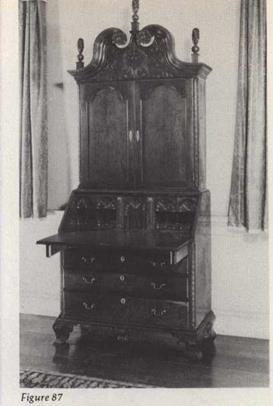 H103W (262.8 cm); originally owned by Michael Withers, near Strasburg, Penn.: асе. no. C51.56.
H103W (262.8 cm); originally owned by Michael Withers, near Strasburg, Penn.: асе. no. C51.56.
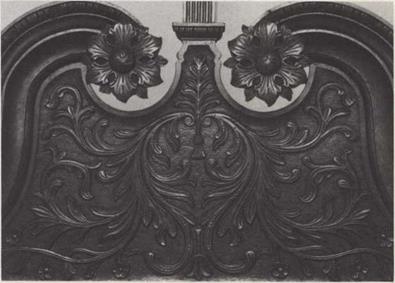
|
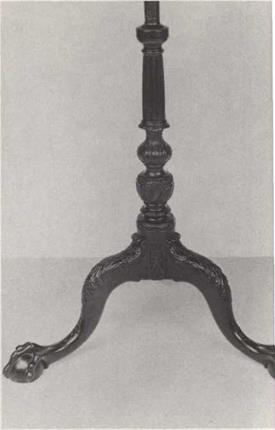
Figures 88 and 89. Fire Screens. There are a few subtle differences, other than carving, that distinguish Philadelphia fire screens from their New York counterparts (Figs. 20,21). The legs of Philadelphia tripod-base furniture dip closer to a floor surface at the point where the legs end and the feet begin. Urns are more likely to be founded, and almost a ball, on the shaft of Philadelphia fire screens. The carved claws of Philadelphia tripod – base feet have the high-ridged knuckles that are expected. In this instance (Fig. 88a), the knuckles are scored to imitate a tightly flexed claw. Hairy paw feet (Fig. 89a) are, of course, common only on English or Philadelphia examples.
А 1772 Philadelphia price list indicates that 2 pounds, 10 shillings was the cost of a mahogany fire screen with claw feet and leaves on the knees.
Two years earlier, Thomas Affleck billed John Cadwalader that amount for each of "4 Mahogany fire screens."<■ At his death in 1776, William Logan had a mahogany "Fire Skreen," listed with a mahogany armchair, in the "Back Chamber Northward" of his Philadelphia town house.*2 Comparison of the turned poles, shafts, tripod bases, and superlative carving of these fire screens, reveals minor differences.
Fig. 88: 1765-80; H 60" (152.2 cm); acc. no.
 C59.3406. Fig. 89: H 62’k" (158.6 cm); acc. no. G60.1065.
C59.3406. Fig. 89: H 62’k" (158.6 cm); acc. no. G60.1065.
|
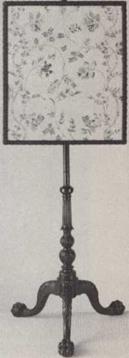
|
Figure 90. Looking Class. Most looking glasses sold in the colonies were imported. But some locally made examples, including this one in the Chinese taste, have survived (Figs. 90-93; PI. XIII). Gabriel Valois advertised in 1773 that he made "looking glass frames. "13 Often the presence of native American wood is the only means of identifying a Chippendale-style looking glass as American. Fig. 90: gold leaf over white and yellow pine; 1760-85; H 484z" (123.2 cm); one of a pair; acc. no. 58.13. |
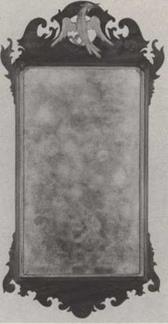 Figure 91. Looking Class. The Chippendale style remained popular in Philadelphia into the last decade of the 18th century. Figure 91 offers proof of this statement because its makers, James and Henry Reynolds, did not succeed their father until after his death in 1794, and they did not move their shop to Market Street until the following year.44 Their label (Fig. 91a), attached to its original white cedar backboard, noted that they executed and sold carved mahogany looking glasses in "pediment, Mock Pediment, Raffled or Ornamented Frames." A gilt phoenix atop a sawn, scalloped crest; pendant and side ornament in rococo fashion; and indented corners at the top of the glass are Chippendale period features. Fig. 91: mahogany veneer over white pine, white cedar, white pine; 1795-1800; H 494*“ (125.1 cm); асе. no. C57.535.
Figure 91. Looking Class. The Chippendale style remained popular in Philadelphia into the last decade of the 18th century. Figure 91 offers proof of this statement because its makers, James and Henry Reynolds, did not succeed their father until after his death in 1794, and they did not move their shop to Market Street until the following year.44 Their label (Fig. 91a), attached to its original white cedar backboard, noted that they executed and sold carved mahogany looking glasses in "pediment, Mock Pediment, Raffled or Ornamented Frames." A gilt phoenix atop a sawn, scalloped crest; pendant and side ornament in rococo fashion; and indented corners at the top of the glass are Chippendale period features. Fig. 91: mahogany veneer over white pine, white cedar, white pine; 1795-1800; H 494*“ (125.1 cm); асе. no. C57.535.
|
|
|
|

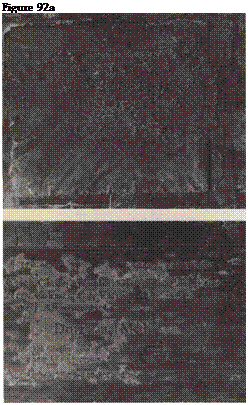
![]() Figures 92 and 93. Looking Classes.
Figures 92 and 93. Looking Classes.
Figure 92 has the label of Joseph White (Fig. 92a), but it is superimposed over another label. Some looking glasses survive that bear both the label of Joseph White and of the Philadelphia cabinet – and looking-glass maker, John Elliott, Sr. (1713-91).™
Significantly, the related looking glass (Figs. 93, 93a) shown here bears a partial label of John Elliott, Jr., (1739-1810). Fig. 92: mahogany over white pine, white cedar, tulip; 1760-75;
H 49’M" (124.6 cm); асе. no. C58.1789.
Fig. 93: mahogany over white pine, white pine; 1784-1803; H 39я/ie"
(100.5 cm); асе. no. C58.1776.

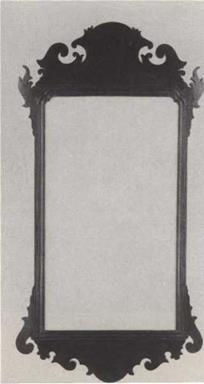 Figure 93
Figure 93
|
Figure 94. Looking Class. Figure 94 reflects several contrasting influences in mid-ieth-century Pennsylvania that point to a rural origin. The grafting of Chippendale-period ornaments onto a late William and Mary or early Queen Anne period frame was common practice in northern Europe. Recovered near Lancaster, Penn., this looking glass was probably made in or near that city. Its bold, molded arched frame matches the shape of door panels found on Pennsylvania bookcases (Fig. 87; PI. XII). Fig. 94: walnut, red or Scots pine; H 60Ve" (152.6 cm); асе. no. C55.52. |
|
|
|
|
Figure 96. Breakfast Table. At the beginning of the Chippendale period, a new form, called a breakfast table, was introduced. It is so described by Chippendale in Plates XXXIII (1754 ed.) or Llll (1762 ed.) of his Director, from which the pierced stretchers and shaped leaves of Figure 96 were adopted. By 1772, breakfast tables were recorded under the general heading of Pembroke tables in the Philadelphia price list for cabinetwork. Drawers in the frame (Figs. 97. 98) were usual, but are lacking in this example.
Fig. 96: mahogany, tulip; 1760-80; W (closed) 24W (62.6 cm), W (open) 48[M" (122.2 cm); асе. no. C61.813.
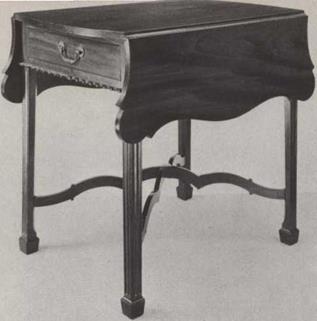
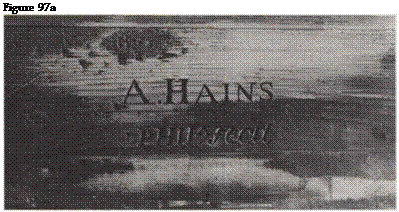 Figure 97
Figure 97
|
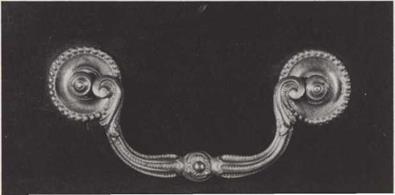
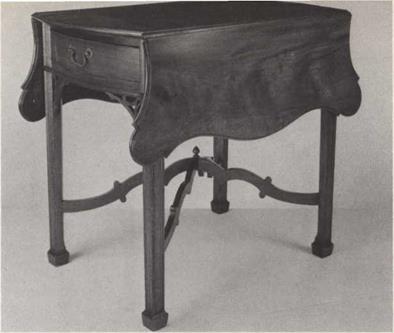
Figure 98
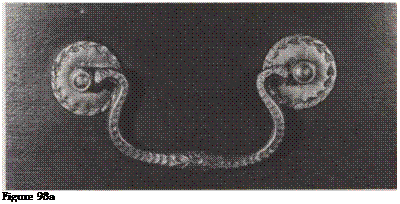
Figures 97 and 98. Breakfast Tables. Adam-style brass drawer pulls, tapered spade feet, and the stamp of Adam Hains (Fig. 97a), a Philadelphia cabinetmaker (w. 1788-1803), mark these tables as transitional between Chippendale and Federal period styles. The same shaped top is found on Philadelphia card tables (Figs. 104-105). Figure 97 has no molded edge to its top; uses gadrooning on the skirt instead of pierced brackets; has straight rails and drawer front instead of the commode front of Figure 98, and more delicate saltire stretchers. Fig. 97: mahogany, white cedar, white oak, tulip; 1788-1803; W (open) 40V (102.6 cm); acc. no. G57.669. Fig.
98: mahogany, white cedar, white oak, tulip; 1785-95; W (open) 42" (106.8 cm); acc. no. C59.3401.

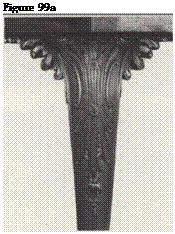 Figure 99. Card Table. Card tables were as popular in Philadelphia as they were in New York (Figs. 30-32). This shares only one feature with New York tables—a concealed drawer behind the swing leg. Figure 99 has a plain top and rails but richly carved gadrooning on its skirt, C-scroll, husk and leaf carving on knees and brackets (Fig. 99a), and hairy paw feet. This table has been attributed to Thomas Affleck because of its probable ownership by John Cadwalader, but no firm evidence exists to support that conclusion.™ Fig. 99: mahogany, white oak, yellow pine; 1760-80: 1N 32" (81.2 cm); асе. no. C52.257.
Figure 99. Card Table. Card tables were as popular in Philadelphia as they were in New York (Figs. 30-32). This shares only one feature with New York tables—a concealed drawer behind the swing leg. Figure 99 has a plain top and rails but richly carved gadrooning on its skirt, C-scroll, husk and leaf carving on knees and brackets (Fig. 99a), and hairy paw feet. This table has been attributed to Thomas Affleck because of its probable ownership by John Cadwalader, but no firm evidence exists to support that conclusion.™ Fig. 99: mahogany, white oak, yellow pine; 1760-80: 1N 32" (81.2 cm); асе. no. C52.257.
Figure 100. Card Table. Unlike Figure 99 and New York card tables, many Philadelphia examples had a long drawer placed in full view (Figs. 101-103).

Plain wood playing surfaces without a cloth cover seem to be the rule for Philadelphia card tables that have survived. The gadrooning applied to the skirt of this table is more subdued than is usually the case with Philadelphia examples. A cartouche surrounded by leaves and C-scrolls is used for knee carving here and on other Philadelphia furniture (Figs. 53, 57-58, 68, 99). Fig. 100: mahogany, tulip; 1765-80; VJ 33lA" (84.4 cm); acc. no. G59.1338.
![]()
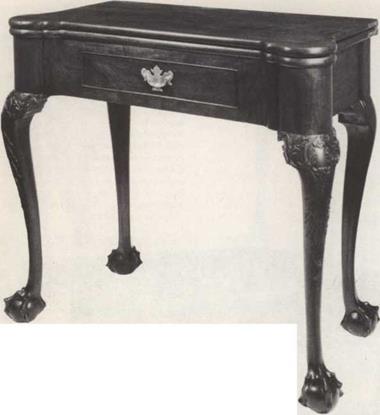 Figure 101. Card Table. Card tables with round corners started at a cost of 5 pounds for one with claw feet and plain knees. With extras, the cost might go as high as 10 pounds (Fig. 103). Figure 101 bears the label (Fig. 101a) of Benjamin Randolph (1737/38-91), a cabinetmaker and skilled woodcarver, whose trade card at the Library Company of Philadelphia establishes his reputation as the Chippendale of colonial America. Fig. 101: mahogany, white oak, tulip; 1765-75; W 33’h" (84.4 cm); acc. no.
Figure 101. Card Table. Card tables with round corners started at a cost of 5 pounds for one with claw feet and plain knees. With extras, the cost might go as high as 10 pounds (Fig. 103). Figure 101 bears the label (Fig. 101a) of Benjamin Randolph (1737/38-91), a cabinetmaker and skilled woodcarver, whose trade card at the Library Company of Philadelphia establishes his reputation as the Chippendale of colonial America. Fig. 101: mahogany, white oak, tulip; 1765-75; W 33’h" (84.4 cm); acc. no.

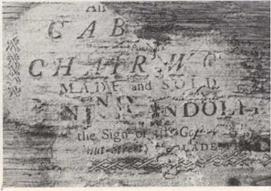 58.85.1.
58.85.1.
|
|
Plate Xlll. Looking Class. One of the most sophisticated American looking glasses extant, this was made by James Reynolds (1736-94) for John Cadwalader.40 Although perfectly balanced, the carved Gothic pilasters, C-scrolls, ruffles, flowers, rocks, husks, and leaves are combined in the airy spirit associated with rococo taste. This glass is closely related to a group owned by the Fisher and Chew families now at Cliveden.50 PI. Xlll: white and yellow pine, tulip; 1770; H 55 ‘V’ (141 cm); асе. no. C52.261.
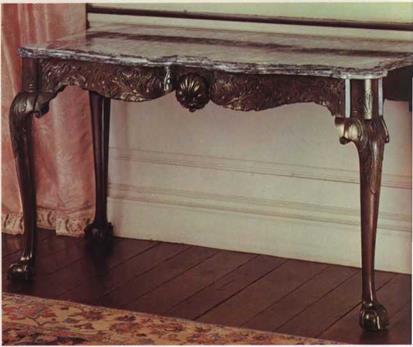
 Plate XIV. Side Table. Sideboard tables could be made with either a wooden or marble top. Because of their use for serving beverages and food, marble was preferred. Philadelphia lists for cabinetwork quote prices for both sideboard tables and frames for marble slabs. The latter were slightly more expensive, perhaps because, as Chippendale indicated, frames to support marble tops had to be heavier. Quarries in nearby Chester County, Penn., supplied Philadelphia artisans with gray and white marble (the type used here), but newspapers record that imported marble was also available. The ruffles, curled leaves, and concave cabochon carved on the front rail; shell carving on the round corners; and curved frame with matching top are all evidence of familiarity with contemporary style.
Plate XIV. Side Table. Sideboard tables could be made with either a wooden or marble top. Because of their use for serving beverages and food, marble was preferred. Philadelphia lists for cabinetwork quote prices for both sideboard tables and frames for marble slabs. The latter were slightly more expensive, perhaps because, as Chippendale indicated, frames to support marble tops had to be heavier. Quarries in nearby Chester County, Penn., supplied Philadelphia artisans with gray and white marble (the type used here), but newspapers record that imported marble was also available. The ruffles, curled leaves, and concave cabochon carved on the front rail; shell carving on the round corners; and curved frame with matching top are all evidence of familiarity with contemporary style.
PI. XIV: mahogany and marble; 1760-70; W 52"
(132 cm); inner frame, one pair of legs and feet restored; acc. no. G60.1064.
Plate XV. Side Chair. This chair may have been part of the furnishings of Mount Clare, built by Charles Carroll the Barrister outside Baltimore. S1A floral and leaf rosette decorates each ear, and leaf carving covers the crest rail. Acanthus leaf and bellflower carving ornaments its broad, interlaced splat. The inner edge of each leg has a broad, tapered chamfer running from seat rail to floor. Southern examples are rare, but the theory that all furniture was imported into the South is being revised as more native examples are found. The seat is covered in cut, uncut, and voided silk velvet (Europe, ca. 1725). PI. XV: mahogany, beech, white pine, tulip: 1765-80; H 37"/ie" (95.7 cm); one of a pair; acc. no. 61.141.1.
Plate XV
|
|
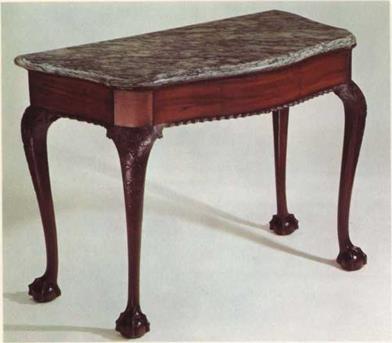 |
Plate XVI. Side Table. In 1920, this table was bought at an auction in South Carolina and was owned there until acquired by Henry Francis du Pont about 1937. Ever since, a controversy has raged over whether the table was made in Charleston, S. C., or in Philadelphia. An authority on Charleston furniture believes it originated there, and Joseph Downs qualified this provenance.52 Its secondary wood, yellow pine, was used in both centers. A relationship between craftsmen in both colonies began as early as 1740 when Josiah Claypoole, "From Philadelphia,"advertised in the South Carolina Gazette that he made furniture, including "Frames for Marble Tables," warranted for 7years "the ill usage of Careless Servants only excepted."53 The quality of this swelled-front table is excellent. Egg-and-dart molding ornaments the top edge of the frame and gadrooning is on its skirt. C-scrolls, leaves, and rosettes appear in cartouche and sunburst patterns on the knees. PI. XVI: mahogany, yellow pine: 1760-75; IN 48" (121.9 cm); acc. no. G60.1071.
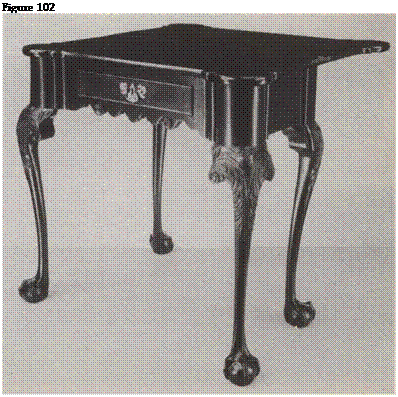 |
Figure 102. Card Table. In all examples of card tables with round corners (Tigs. 101,103), the hinged tops follow the shapes of their frames. Here, the upper edge of the rear legs is finished with a half-round molding, a detail that occurs on well-made Philadelphia card tables. A very nice feature of Figure 102 is that the knees of all four legs are carved. Its shaped skirt with volutes is another example of the popularity of Queen Anne design and its use on Chippendale-style furniture in the Quaker City. Fig. 102: mahogany, white cedar, white oak, yellow pine, tulip; 1755-75; W 325/s" (82.8 cm); one of a pair; acc. no. G58.2247.
|
|
|

 Figure 103. Gaming Table. This table, the same type as Figures 101 and 102, is very similar to pairs of card tables in Hornor’sBlue Book.54 Carved latticework, C-scrolls, leaves, and ruffles cover the turrets, knees, and rails of this pair of tables (Figs. 103a, b). Should this ornamentation fail to announce the owner’s familiarity with the new style, the asymmetrical pendant shell at the center of the skirt would. Fig. 103: mahogany, white cedar, white oak; 1760-75; W (top) 32’/*" (81.9 cm); one of a pair; acc. no.
Figure 103. Gaming Table. This table, the same type as Figures 101 and 102, is very similar to pairs of card tables in Hornor’sBlue Book.54 Carved latticework, C-scrolls, leaves, and ruffles cover the turrets, knees, and rails of this pair of tables (Figs. 103a, b). Should this ornamentation fail to announce the owner’s familiarity with the new style, the asymmetrical pendant shell at the center of the skirt would. Fig. 103: mahogany, white cedar, white oak; 1760-75; W (top) 32’/*" (81.9 cm); one of a pair; acc. no.
G60.1055.1.
Figure 103b

